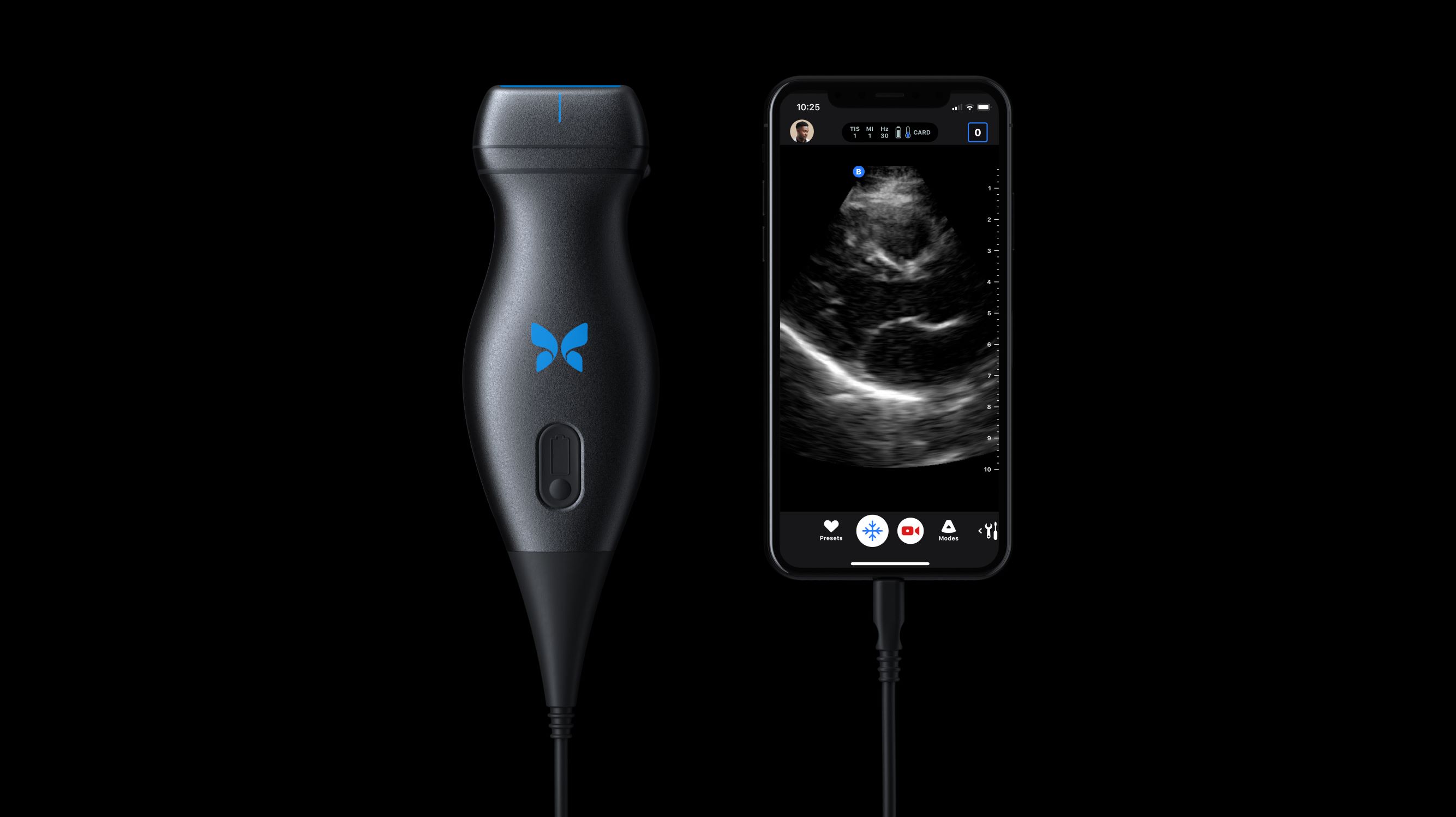
Butterfly iQ handheld whole-body ultrasound system.
Butterfly iQ is one of the first handheld whole-body ultrasound systems. By making medical imaging universally accessible and affordable, Butterfly is democratizing healthcare. Ultrasound technology plays an essential role in every human health condition. With Butterfly iQ, the collective intelligence of the global medical community can reach even the most remote places on earth, ushering in a new era of healthcare.
Butterfly has reinvented ultrasound from the ground up. Powered by a single silicon chip on a handheld, smartphone-connected device, Butterfly provides a personalized experience for healthcare providers at a drastically lower cost—starting under $2,000. Butterfly iQ offers ease of use, leveraging artificial intelligence for an intuitive ultrasound experience. With an integrated software platform, Butterfly provides a seamless connection for professionals to collaborate across the hospital or around the world.
Butterfly iQ is about the size of a smartphone and is 80 percent less expensive than previous portable ultrasounds. “Butterfly iQ expands the use of ultrasound to a wider range of clinical contexts,” says Jimmy Jia, principal scientist at Butterfly Network. “For example, in emergency rooms, there often isn’t time to wheel in a traditional ultrasound cart. But it would be very feasible for every emergency physician or nurse to have a Butterfly iQ scanner in their pocket.”
However, the hardware is only part of the picture. It’s the cloud-based software innovation behind it that truly makes it unique. “Using AWS Cloud services, we can put advanced imaging capabilities in the hands of many more people around the world and empower them with new ways to securely store, share, and collaborate with medical images,” says Jia. “Additionally, we can make our solution smarter over time by analyzing the resulting data.”
To make this ambitious vision possible, Butterfly Network chose Amazon Web Services (AWS) as the technology foundation for Butterfly Cloud, its cloud services platform. “AWS has always been our first choice,” says Jia. “It is a clear market leader due to its scalability, innovation, and breadth. We have been able to derive value from using more and more services as we go along.”
Starting with Amazon Elastic Compute Cloud (Amazon EC2), Amazon Simple Storage Service (Amazon S3), and Amazon Relational Database Service (Amazon RDS), the company has expanded its use of AWS technology to create richer clinical tools and pursue advanced data science approaches.

Butterfly architecture diagram.
Big-data analytics is a major component of Butterfly Network’s strategy for making ultrasound easier to use. “Even a common application of ultrasound, such as taking an image of the heart, can be difficult without training,” says Jia. “Using artificial intelligence and deep-learning models trained on AWS, we can allow users with less training to operate our ultrasound device, interpret the captured images, and make more consistent measurements. Augmented reality will enable us to overlay directional indicators on the patient to make it possible for almost anyone to use ultrasound properly.”
Developing these guided ultrasound experiences using machine learning takes a lot of data and computing horsepower. The data science team at Butterfly Network uses a high-performance computing (HPC) stack built on AWS, comprising Amazon EC2 instances for processing, Amazon RDS for data structure and querying, Amazon S3 for object storage, and Amazon’s open-source CfnCluster solution that enables rapid deployment of HPC clusters on AWS.
One of the key AWS technologies the team uses for its data science efforts is Amazon Elastic File System (Amazon EFS). Amazon EFS provides massively parallel shared file system access to thousands of Amazon EC2 instances, enabling applications to achieve high levels of aggregate throughput and IOPS that scale as a file system grows. It offers consistent low latencies and compatibility with the Network File System protocol.
This fully managed service means that Butterfly Network can focus on delivering innovative products, services, and insights rather than managing storage systems. “Our previous storage architecture would take down the cluster if a fault occurred,” says Jack Levy, head of cloud engineering at Butterfly Network. “When the cluster’s not working, we have an entire team of deep-learning scientists sitting idle. Amazon EFS just works, so we can concentrate on building models that drive better patient care.”
Because its solution handles protected health information, Butterfly Network must comply with the Health Information Portability and Accountability Act (HIPAA). This is another reason the company chose the AWS Cloud: many AWS services are HIPAA-eligible. Because these services are designed to help customers meet HIPAA requirements out of the box, Butterfly Network greatly reduced the complexity of building an architecture that was compliant with HIPAA regulations.
For example, the robust logging features available across HIPAA-eligible AWS services make it simple to capture and preserve required access logs, which Butterfly Network then stores cost-effectively and securely using encrypted Amazon S3 buckets. “AWS solutions are designed with features to handle regulated data, significantly reducing the burden on our developers,” says Levy. “AWS can enter into a HIPAA Business Associate Agreement and greatly simplify our work to achieve compliance.”
Jia notes that this compliance is critical to the company’s mission. “We can reassure customers that their data is being handled in a professional, secure, compliant way,” says Jia. “This enables the positive feedback loop of using that data to deliver better services.”
Learn more about Amazon Elastic File System.
